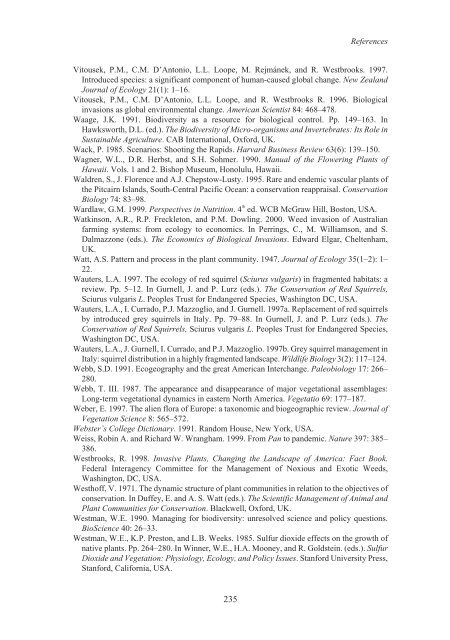Alien Species.vp - IUCN
Alien Species.vp - IUCN
Alien Species.vp - IUCN
You also want an ePaper? Increase the reach of your titles
YUMPU automatically turns print PDFs into web optimized ePapers that Google loves.
Vitousek, P.M., C.M. D’Antonio, L.L. Loope, M. Rejmánek, and R. Westbrooks. 1997.<br />
Introduced species: a significant component of human-caused global change. New Zealand<br />
Journal of Ecology 21(1): 1–16.<br />
Vitousek, P.M., C.M. D’Antonio, L.L. Loope, and R. Westbrooks R. 1996. Biological<br />
invasions as global environmental change. American Scientist 84: 468–478.<br />
Waage, J.K. 1991. Biodiversity as a resource for biological control. Pp. 149–163. In<br />
Hawksworth, D.L. (ed.). The Biodiversity of Micro-organisms and Invertebrates: Its Role in<br />
Sustainable Agriculture. CAB International, Oxford, UK.<br />
Wack, P. 1985. Scenarios: Shooting the Rapids. Harvard Business Review 63(6): 139–150.<br />
Wagner, W.L., D.R. Herbst, and S.H. Sohmer. 1990. Manual of the Flowering Plants of<br />
Hawaii. Vols. 1 and 2. Bishop Museum, Honolulu, Hawaii.<br />
Waldren, S., J. Florence and A.J. Chepstow-Lusty. 1995. Rare and endemic vascular plants of<br />
the Pitcairn Islands, South-Central Pacific Ocean: a conservation reappraisal. Conservation<br />
Biology 74: 83–98.<br />
Wardlaw, G.M. 1999. Perspectives in Nutrition. 4 th<br />
ed. WCB McGraw Hill, Boston, USA.<br />
Watkinson, A.R., R.P. Freckleton, and P.M. Dowling. 2000. Weed invasion of Australian<br />
farming systems: from ecology to economics. In Perrings, C., M. Williamson, and S.<br />
Dalmazzone (eds.). The Economics of Biological Invasions. Edward Elgar, Cheltenham,<br />
UK.<br />
Watt, A.S. Pattern and process in the plant community. 1947. Journal of Ecology 35(1–2): 1–<br />
22.<br />
Wauters, L.A. 1997. The ecology of red squirrel (Sciurus vulgaris) in fragmented habitats: a<br />
review. Pp. 5–12. In Gurnell, J. and P. Lurz (eds.). The Conservation of Red Squirrels,<br />
Sciurus vulgaris L. Peoples Trust for Endangered <strong>Species</strong>, Washington DC, USA.<br />
Wauters, L.A., I. Currado, P.J. Mazzoglio, and J. Gurnell. 1997a. Replacement of red squirrels<br />
by introduced grey squirrels in Italy. Pp. 79–88. In Gurnell, J. and P. Lurz (eds.). The<br />
Conservation of Red Squirrels, Sciurus vulgaris L. Peoples Trust for Endangered <strong>Species</strong>,<br />
Washington DC, USA.<br />
Wauters, L.A., J. Gurnell, I. Currado, and P.J. Mazzoglio. 1997b. Grey squirrel management in<br />
Italy: squirrel distribution in a highly fragmented landscape. Wildlife Biology 3(2): 117–124.<br />
Webb, S.D. 1991. Ecogeography and the great American Interchange. Paleobiology 17: 266–<br />
280.<br />
Webb, T. III. 1987. The appearance and disappearance of major vegetational assemblages:<br />
Long-term vegetational dynamics in eastern North America. Vegetatio 69: 177–187.<br />
Weber, E. 1997. The alien flora of Europe: a taxonomic and biogeographic review. Journal of<br />
Vegetation Science 8: 565–572.<br />
Webster’s College Dictionary. 1991. Random House, New York, USA.<br />
Weiss, Robin A. and Richard W. Wrangham. 1999. From Pan to pandemic. Nature 397: 385–<br />
386.<br />
Westbrooks, R. 1998. Invasive Plants, Changing the Landscape of America: Fact Book.<br />
Federal Interagency Committee for the Management of Noxious and Exotic Weeds,<br />
Washington, DC, USA.<br />
Westhoff, V. 1971. The dynamic structure of plant communities in relation to the objectives of<br />
conservation. In Duffey, E. and A. S. Watt (eds.). The Scientific Management of Animal and<br />
Plant Communities for Conservation. Blackwell, Oxford, UK.<br />
Westman, W.E. 1990. Managing for biodiversity: unresolved science and policy questions.<br />
BioScience 40: 26–33.<br />
Westman, W.E., K.P. Preston, and L.B. Weeks. 1985. Sulfur dioxide effects on the growth of<br />
native plants. Pp. 264–280. In Winner, W.E., H.A. Mooney, and R. Goldstein. (eds.). Sulfur<br />
Dioxide and Vegetation: Physiology, Ecology, and Policy Issues. Stanford University Press,<br />
Stanford, California, USA.<br />
235<br />
References












